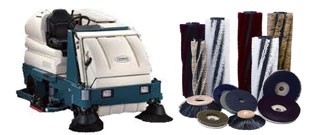|
 Sweeper Parts Saskatchewan - The Province of Saskatchewan is the third westernmost province within Canada. It is situated within the Canadian prairies with an area which encompasses 227,100 square miles or 588,276 square kilometres. The province of Alberta forms the border to the west, the Northwest Territories are the northern border, the province of Manitoba lies towards the east and the U.S. states of North Dakota and Montana are on the south.
The population of the province is approximately 1,053,960, according to the most current statistics. The majority of the provinces inhabitants reside in Southern Saskatchewan. About 257,300 residents live within Saskatoon which is likewise the province's largest city. The capital city is Regina and approximately 210,000 residents live there. Amongst the other major cities are Moose Jaw, North Battleford, Prince Albert, Swift Current and Yorkton.
The area of the province of Saskatchewan was first explored in the year 1690 by Europeans and settled in the year 1774. Some indigenous groups have also colonized the region. During the year 1905, Saskatchewan became a province. Brad Wall is the existing premier and the lieutenant-governor is Gordon Barnhart. Mining, energy and agriculture are the major businesses.
"Saskatchewan" is a name which originates from the Saskatchewan River. In the Cree language the river was designated kisiska-ciwani-si-piy that means swift flowing river.
The economy of the province of Saskatchewan is associated largely with agriculture. Over the years there has been increasing diversification and now, fishing, forestry, agriculture, and hunting combined only amount for 6.8% of the GDP of the province. A big portion of Canada's grain is grown by the province of Saskatchewan. The most familiar crop being wheat and this is often associated with the province of Saskatchewan in the form of wheat sheafs depicted on the coat of arms of Saskatchewan. The province produces other grains like for instance oats, flax, canola, rye, peas, canary seed and barley.
Saskatchewan's beef cattle production is another flourishing business, the second largest within the nation following the province of Alberta. Mining is quite prominent within the province of Saskatchewan as it is the largest exporter of uranium and potash. Forestry is one more significant industry which is predominant in the northern portion of the province.
Oil and natural gas production are also key parts of the economy of the province with oil being the bigger trade. In overall oil production, just the province of Alberta exceeds the province of Saskatchewan. Within the Lloydminister-Kerrobert-Kindersley areas, heavy crude is extracted. Within the Kindersley-Swift Current areas along with the Weyburn-Estevan fields, light crude is also found. From the Primrose Lake region through Kindersley, Lloydminister, Leader, Unity and Maple Creek areas and most of the entire western portion of the province of Saskatchewan, natural gas is abundant.
There are various large Crown corporations in the province of Saskatchewan, like for instance SaskEnergy, a key supplier of natural gas within the province; SGI or likewise referred to as Saskatchewan Government Insurance, SaskPower and SaskTel. The NATO Flying Training Centre at 15 Wing, close to Moose Jaw is run by Bombardier. In the latter part of the 1990s, Bombardier was awarded a long-term contract for $2.8 billion from the federal government for the running of the facility and the purchase of military aircraft.
Ever since the year 1929, SaskPower has been the principal supplier of electricity within the province of Saskatchewan. They manage over $4.5 billion in assets and serve over four hundred fifty one thousand clients. SaskPower is a huge employer who has close to 2500 permanent full-time staff situated within seventy one communities.
| |
















